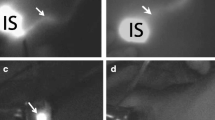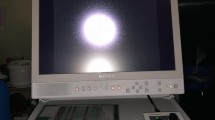Abstract
Sentinel lymph node (SLN) biopsy using indocyanine green (ICG) fluorescence is safe and has a high detection rate for SLNs. However, the results of this novel technique are heterogeneous. The objective of this meta-analysis was to evaluate the diagnostic performance of the ICG fluorescence method compared with the standard radioisotope (RI) method. All eligible studies were identified from 2005 through 2015. A proportion meta-analysis was performed using a fixed effects and/or random effects model based on the study heterogeneity. A total of 12 studies met the inclusion criteria and included 1736 women. There was no significant difference between ICG fluorescence and RI for SLN detection using either the fixed effects model [odds ratio (OR) 1.29, 95% confidence interval (CI) 0.87–1.90] or the random effects model (OR 1.32, 95% CI 0.54–3.18). There were seven studies reporting the detection rate for tumor-positive SLN. The ICG fluorescence method was significantly better than the RI method in the fixed effects model (OR 1.87, 95% CI 1.00–3.49) for staging axilla. However, there was no difference in the random effects model (OR 1.90, 95% CI 0.74–4.86). There was study outcome heterogeneity for the detection of SLN but not for tumor-positive SLN. There was no publication bias observed in the studies included. The ICG fluorescence method has valid diagnostic performance for SLN detection and shows a trend toward better axilla staging compared with the RI method. ICG fluorescence is a useful alternative to RI for SLN biopsy.




Similar content being viewed by others
References
Mansel RE, Fallowfield L, Kissin M et al (2006) Randomized multicenter trial of sentinel node biopsy versus standard axillary treatment in operable breast cancer: the ALMANAC trial. J Natl Cancer Inst 98:599–609
Purushotham AD, Upponi S, Klevesath MB et al (2005) Morbidity after sentinel lymph node biopsy in primary breast cancer: results from a randomized controlled trial. J Clin Oncol 23:4312–4321
Kim T, Guiliano AE, Lyman GH (2006) Lymphatic mapping and sentinel lymph node biopsy in early-stage breast carcinoma. Cancer 106:4–16
Krag DN, Anderson SJ, Julian TB et al (2007) Technical outcome of sentinel-lymph-node resection and conventional axillary lymph node dissection in patients with clinically node-negative breast cancer: result from the NSABP B-32 randomized phase III trial. Lancet Oncol 8:881–888
Benson JR, Querci della Rovere GQ, The Axilla Management Consensus Group (2007) Management of the axilla in women with breast cancer. Lancet Oncol 8:331–348
Morrow M, Rademaker AW, Bethke KP et al (1999) Learning sentinel node biopsy: results of a prospective randomized trial of two techniques. Surgery 126:714–720
Kitai T, Inomoto T, Miwa M et al (2005) Fluorescence navigation with indocyanine green for detecting sentinel lymph nodes in breast cancer. Breast Cancer 12:211–215
Sugie T, Kassim KA, Takeuchi M et al (2010) A novel method for sentinel lymph node biopsy by indocyanine green fluorescence technique in breast cancer. Cancers 2:713–720
von Elm E, Altman DG, Egger M et al (2007) The strengthening the reporting of observational studies in epidemiology (STROBE) statement: guidelines for reporting observational studies. Lancet 370:1453–1457
The Nordic Cochrane Centre, Cochrane Collaboration (2014) Review Manager (RevMan) version 5.3. (Computer program). Copenhagen. http://tech.cochrane.org/revan/download
Murawa D, Hirche C, Dresel S et al (2009) Sentinel lymph node biopsy in breast cancer guided by indocyanine green fluorescence. Br J Surg 96:1289–1294
Hojo T, Nagao T, Kikuyama M et al (2010) Evaluation of sentinel node biopsy by combined fluorescence and dye method and lymph flow for breast cancer. Breast 19:210–213
Wishart GC, Loh SW, Jones L et al (2012) A feasibility study (ICG-10) of indocyanine green (ICG) fluorescence mapping for sentinel lymph node detection in early breast cancer. Eur J Surg Oncol 38:651–656
Polom K, Murawa D, Nowaczyk P et al (2012) Breast cancer sentinel lymph node mapping using near infrared guided indocyanine green and indocyanine green-human serum albumin in comparison with gamma emitting radioactive colloid tracer. Eur J Surg Oncol 38:137–142
van der Vorst JR, Schaafsma BE, Verbeek FP et al (2012) Randomized comparison of near-infrared fluorescence imaging using indocyanine green and 99mtechnetium with or without patent blue for the sentinel lymph node procedure in breast cancer patients. Ann Surg Oncol 19:4104–4111
Schaafsma BE, Verbeek FP, Riebergen DD et al (2013) Clinical trial of combined radio- and fluorescence-guided sentinel lymph node biopsy in breast cancer. Br J Surg 100:1037–1044
Ballardini B, Santoro L, Sangalli C et al (2013) The indocyanine green method is equivalent to the 99mTc-labeled radiotracer method for identifying the sentinel node in breast cancer: a concordance and validation study. Eur J Surg Oncol 39:1332–1336
Samorani D, Fogacci T, Panzini I et al (2015) The use of indocyanine green to detect sentinel nodes in breast cancer: a prospective study. Eur J Surg Oncol 41:64–70
Verbeek FP, Troyan SL, Mieog JS et al (2014) Near-infrared fluorescence sentinel lymph node mapping in breast cancer: a multicenter experience. Breast Cancer Res Treat 143:333–342
Jung SY, Kim SK, Kim SW et al (2014) Comparison of sentinel lymph node biopsy guided by the multimodal method of indocyanine green fluorescence, radioisotope, and blue dye versus the radioisotope method in breast cancer: a randomized controlled trial. Ann Surg Oncol 21:1254–1259
Grischke EM, Röhm C, Hahn M et al (2015) ICG fluorescence technique for the detection of sentinel lymph nodes in breast cancer: results of a prospective open-label clinical trial (in English). Geburtshilfe Frauenheilkd 75:935–940
Sugie T, Kinoshita T, Masuda N et al (2016) Evaluation of the clinical utility of the ICG fluorescence method compared with the radioisotope method for sentinel lymph node biopsy in breast cancer. Ann Surg Oncol 23:44–50
Benson RC, Kunes HA (1978) Fluorescence properties of indocyanine green as related to angiography. Phys Med Biol 23:159–163
Shikayama T (2016) Characteristics of the photodynamic eye camera. In: Kusano M et al (eds) ICG fluorescence imaging and navigation surgery. Springer, Tokyo, pp 21–27
Mieog JS, Troyan SL, Hutteman M et al (2011) Toward optimization of imaging system and lymphatic tracer for near-infrared fluorescent sentinel lymph node mapping in breast cancer. Ann Surg Oncol 18:2483–2491
Xiong L, Gazyakan E, Yang W et al (2014) Indocyanine green fluorescence-guided sentinel node biopsy: a meta-analysis on detection rate and diagnostic performance. Eur J Surg Oncol 40:843–849
Zhang X, Li Y, Zhou Y et al (2016) Diagnostic performance of indocyanine green-guided sentinel lymph node biopsy in breast cancer: a meta-analysis. PLoS One 11:e0155597
Sugie T, Sawada T, Tagaya N et al (2013) Comparison of the indocyanine green fluorescence and blue dye methods in detection of sentinel lymph nodes in early-stage breast cancer. Ann Surg Oncol 20:2213–2218
Ahmed M, Purushotham AD, Douek M (2014) Novel techniques for sentinel lymph node biopsy in breast cancer: a systematic review. Lancet Oncol 15:e351–e362
Ikeda T, Sugie T, Shimizu A et al (2016) Patterns of clinical practice for sentinel lymph node biopsy in women with node-negative breast cancer: the results of a national survey in Japan. Breast Cancer. doi:10.1007/s12282-016-0720-5 (in press)
Acknowledgements
This work is supported by research funding from Hamamatsu Photonics.
Author information
Authors and Affiliations
Corresponding author
Ethics declarations
Conflict of interest
Tomoharu Sugie received honoraria from Hamamatsu Photonics. The other authors declare no conflict of interest.
Electronic supplementary material
Below is the link to the electronic supplementary material.
About this article
Cite this article
Sugie, T., Ikeda, T., Kawaguchi, A. et al. Sentinel lymph node biopsy using indocyanine green fluorescence in early-stage breast cancer: a meta-analysis. Int J Clin Oncol 22, 11–17 (2017). https://doi.org/10.1007/s10147-016-1064-z
Received:
Accepted:
Published:
Issue Date:
DOI: https://doi.org/10.1007/s10147-016-1064-z




